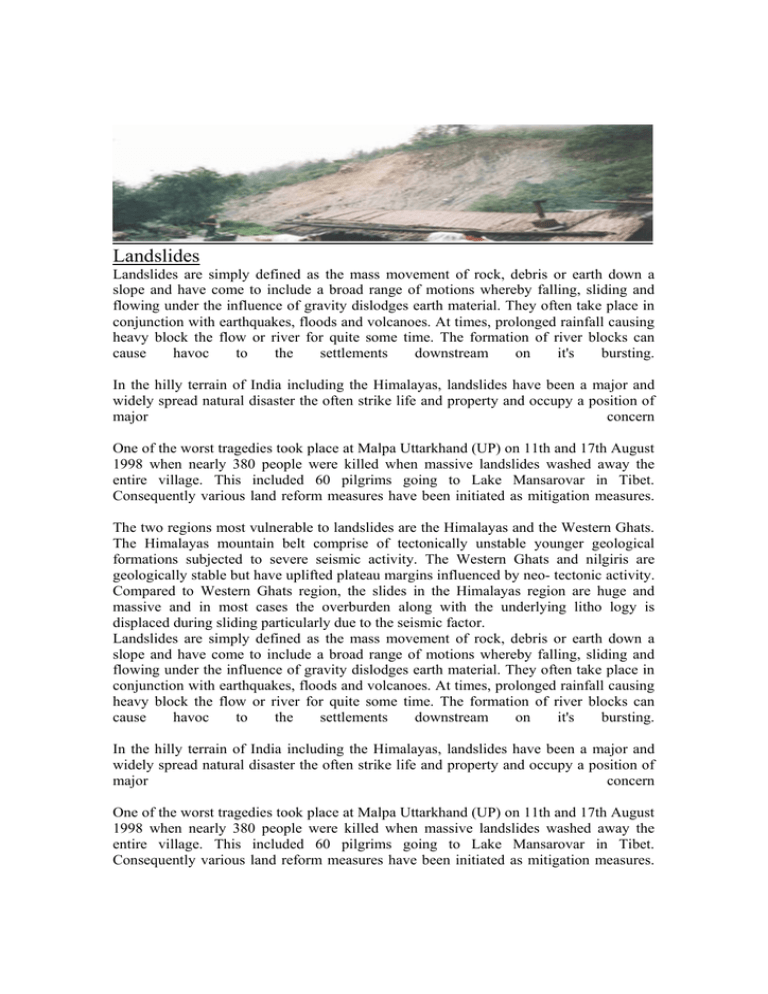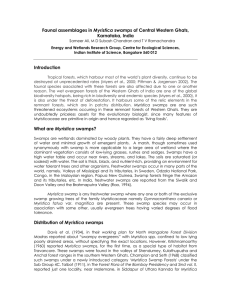Landslides
advertisement

Landslides Landslides are simply defined as the mass movement of rock, debris or earth down a slope and have come to include a broad range of motions whereby falling, sliding and flowing under the influence of gravity dislodges earth material. They often take place in conjunction with earthquakes, floods and volcanoes. At times, prolonged rainfall causing heavy block the flow or river for quite some time. The formation of river blocks can cause havoc to the settlements downstream on it's bursting. In the hilly terrain of India including the Himalayas, landslides have been a major and widely spread natural disaster the often strike life and property and occupy a position of major concern One of the worst tragedies took place at Malpa Uttarkhand (UP) on 11th and 17th August 1998 when nearly 380 people were killed when massive landslides washed away the entire village. This included 60 pilgrims going to Lake Mansarovar in Tibet. Consequently various land reform measures have been initiated as mitigation measures. The two regions most vulnerable to landslides are the Himalayas and the Western Ghats. The Himalayas mountain belt comprise of tectonically unstable younger geological formations subjected to severe seismic activity. The Western Ghats and nilgiris are geologically stable but have uplifted plateau margins influenced by neo- tectonic activity. Compared to Western Ghats region, the slides in the Himalayas region are huge and massive and in most cases the overburden along with the underlying litho logy is displaced during sliding particularly due to the seismic factor. Landslides are simply defined as the mass movement of rock, debris or earth down a slope and have come to include a broad range of motions whereby falling, sliding and flowing under the influence of gravity dislodges earth material. They often take place in conjunction with earthquakes, floods and volcanoes. At times, prolonged rainfall causing heavy block the flow or river for quite some time. The formation of river blocks can cause havoc to the settlements downstream on it's bursting. In the hilly terrain of India including the Himalayas, landslides have been a major and widely spread natural disaster the often strike life and property and occupy a position of major concern One of the worst tragedies took place at Malpa Uttarkhand (UP) on 11th and 17th August 1998 when nearly 380 people were killed when massive landslides washed away the entire village. This included 60 pilgrims going to Lake Mansarovar in Tibet. Consequently various land reform measures have been initiated as mitigation measures. The two regions most vulnerable to landslides are the Himalayas and the Western Ghats. The Himalayas mountain belt comprise of tectonically unstable younger geological formations subjected to severe seismic activity. The Western Ghats and nilgiris are geologically stable but have uplifted plateau margins influenced by neo- tectonic activity. Compared to Western Ghats region, the slides in the Himalayas region are huge and massive and in most cases the overburden along with the underlying litho logy is displaced during sliding particularly due to the seismic factor. Man- made Causes • • • • • • • • Excavation (particularly at the toe of slope Loading of slope crest Draw -down (of reservoir) Deforestation Irrigation Mining Artificial vibrations Water impoundment and leakage from utilities An overall evaluation of the pattern and nature of landslide2 occurrences in the Kerala part of Western Ghats and its corresponding eastern flank falling within Tamil Nadu reveals the following main features: • • • • • • Almost all mass movements occur during monsoons (SW and NE monsoon) in the western flank of western Ghats and during occasional cyclonic events in the eastern flank indicating that main triggering mechanism is the over- saturation of overburden caused by heavy rains There seems to be a relation between intensity of rainfall and slope failures. Majority of the catastrophic mass movements is confined to the overburden without affecting the underlying bedrock. Improper land use practices such as heavy tilling, agricultural practices and settlement patterns have contributed to creep and withdrawal of toe support in many cases A common factor noticed in most of these vulnerable slopes deforestation in the recent past, cultivation of seasonal crops and increase in settlements. In all the vulnerable slopes terracing/ contour bounding is adopted mainly to prevent soil erosion and to enhance percolation during dry season for cultivation of cash crops as well as seasonal crops. Invariably, in all these cases, natural drainage lines on slopes are blocked or modified without • adequate provision for surface drainage of excess storm water during high intensity rains prevalent in the area. In some areas developmental activities like construction of buildings, road cutting, embankments, cut and fill structures causes modification of natural slopes, blocking of surface drainage, loading of critical slopes and withdrawal to toe support promoting vulnerability of critical slopes. Mitigatory Measures In general the chief mitigatory measures to be adopted for such areas are • • • • Drainage correction, Proper land use measures, Reforestation for the areas occupied by degraded vegetation and Creation of awareness among local population. The most important triggering mechanism for mass movements is the water infiltrating into the overburden during heavy rains and consequent increase in pore pressure within the overburden. When this happens in steep slopes the safety factor of the slope material gets considerably reduced causing it to move down. Hence the natural way of preventing this situation is by reducing infiltration and allowing excess water to move down without hindrance. As such, the first and foremost mitigation measure is drainage correction. This involves maintenance of natural drainage channels both micro and macro in vulnerable slopes. The universal use of contour bounding for all types of terrain without consideration of the slope, overburden thickness and texture or drainage set- up needs to be controlled especially in the plateau edge regions. It is time to think about alternative and innovations, which are suitable for the terrain, to be set up. It need not be overemphasized the governmental agencies have a lot to contribute in this field. Leaving aside the 'critical zones' with settlements could be avoided altogether and which could be preferably used for permanent vegetation, the 'highly unstable zones' generally lie in the upper regions, which are occupied by highly degraded vegetation. These areas warrant immediate afforestation measures with suitable plant species. The afforestation programme should be properly planned so the little slope modification is done in the process. Bounding of any sort using boulders etc. has to be avoided. The selection of suitable plant species should be such that can with stand the existing stress conditions in this terrain.




